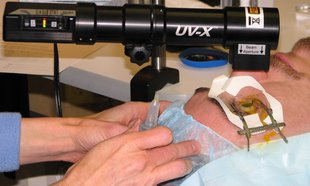Keratoconus (kehr-uh-toh-KOH-nus) is the most common corneal dystrophy that leads to severe visual impairment. It affects 1 in every 2000 people and is 15% more common in individuals with Down syndrome. Although not a common known eye disorder, it is by no means rare, and it is becoming more common due to the use of modern diagnostic equipment.
Keratoconus is a condition in which the normally round, dome-shaped cornea (front window of the eye) thins and becomes distorted and irregular. A cone-like bulge develops, resulting in significant visual distortion. The apex of the cone is usually displaced outwards and downwards and in the line of sight, creating irregular astigmatism.
Keratoconus is typically diagnosed in the late teens or early 20's, although it is occassionally diagnosed in young children as well as people in their 30's or 40's. It us usually slow to progress, taking 10 to 20 years, but sometimes it is very rapidly progressing going to an advanced stage in as short as 6 to 12 months from diagnosis. In our experiences, this seems to be a more common occurrance for individuals with Down syndrome. Also, At this time, there is no known cause, but studies have shown that genes on chromosomes 21, 17 and 13 may play a role. In addition, eye rubbing has been suggested to be a cause as well.
Until recently, there has been no treatment that stopped the progression of Keratoconus and instead the symptoms were treated keratoconus is treated through eyeglasses, hard contact lenses, and a newer treatment, INTACS plastic rings inserted into the mid layer of the cornea to flatten it, changing the shape and location of the cone. Again, these just corrected the distorted vision of Keratoconus patients, but did not stop the progression of the disease.
In 15-20% of the cases, cornea transplant surgery is necessary. When vision can no longer be corrected with contacts or the patient can no longer tolerate the uncomfortable contacts, a cornea transplant is the next option. Cornea transplants are the most common type of solid tissue transplant, and Keratoconus is the major cause of cornea transplantation in the Western world.
Maybe this "treatment" of Keratoconus is changing, so that rather than treat the symptoms (but still have the disease progress), the disease can actually be treated. Approximately 10 years ago, Dr. Theo Seiler developed a procedure called Corneal Cross-linking (CXL).
skip to main |
skip to sidebar

CXL is a procedure that involves administering riboflavin and UVA in carefully selected parameters that strengthen the front layers of the cornea and avoid damage to the back of the eye.
Click on below link to Watch in HD on large screen
Get an email everytime we post with new update.
CXL Procedure

CXL is a procedure that involves administering riboflavin and UVA in carefully selected parameters that strengthen the front layers of the cornea and avoid damage to the back of the eye.
Keratoconus and CXL links and articles
- Nick Richards blog
- Video Clip about CXL
- Collagen Crosslinking with Riboflavin as a Photosynthesizer
- ClinicalTrial.gov (U.S. CXL study sites)
- One of a Kind Eye Treatment
- Mom Always Said, "Don't Rub Your Eyes"
- National Keratoconus Foundation
- Cornea Research Foundation of America
- The Global Keratoconus Foundation
- Keratoconus on Wikipedia
Blog Archive
About Us
- Janis "Widget" (Marietta, GA) and Connie (Mason, OH)
- We are each moms of incredible sons with Down syndrome who have also both been diagnosed with Keratoconus, one at age 25 and one at age 12. It progressed very rapidly in both our sons, going from mild to advanced in less than a year. CXL seemed like a miracle for us. This blog is to bring awareness of this wonderful treatment of Keratoconus and to encourage the FDA to "fast track" the approval of CXL.

